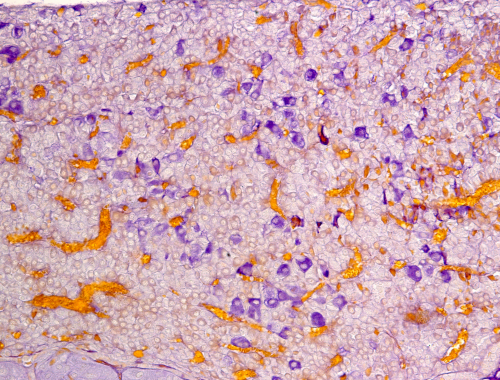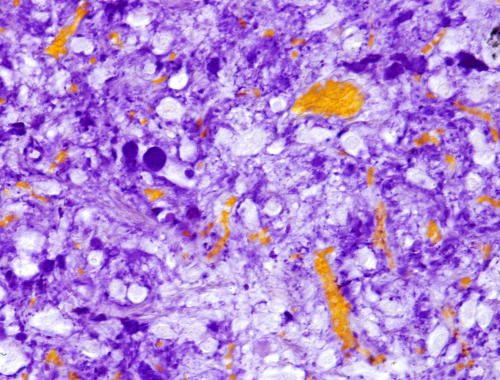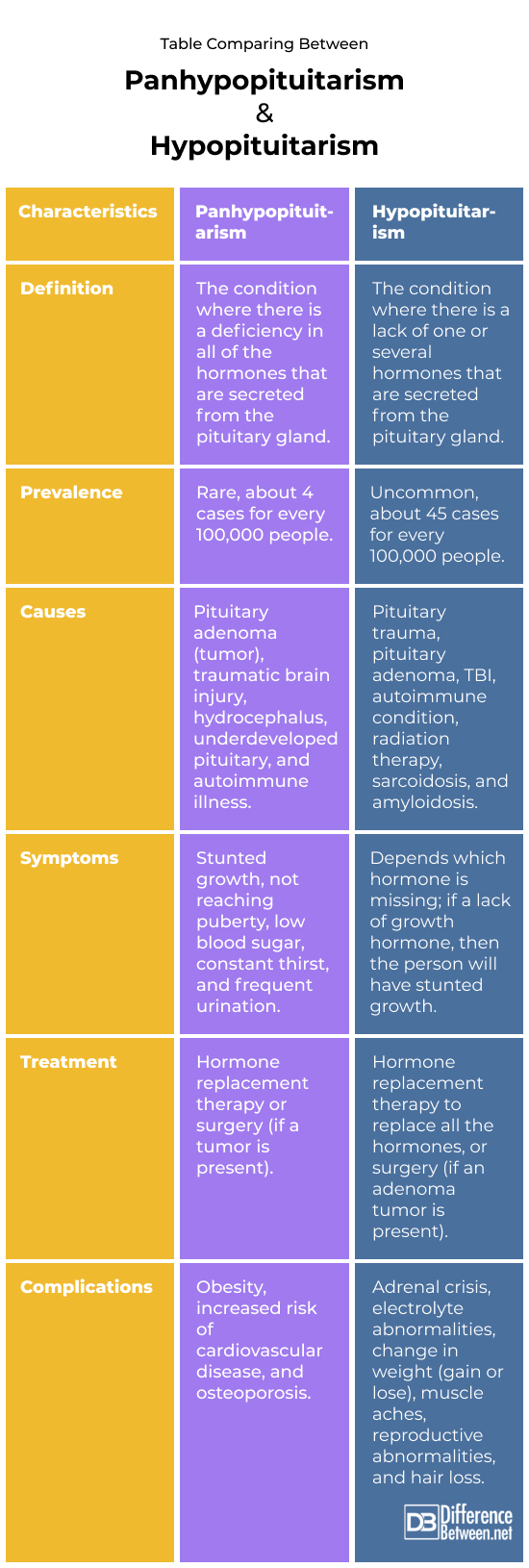Difference Between Panhypopituitarism and Hypopituitarism
Panhypopituitarism is when no hormones are released from the pituitary gland. Hypopituitarism is when there is a lack of one or more of the pituitary gland hormones.

What is Panhypopituitarism?
Definition:
Panhypopituitarism is the disorder where there are no pituitary gland hormones being produced.
Causes and prevalence:
There are several causes of panhypopituitarism but the most common is a pituitary tumor known as an adenoma. Other reasons you may develop this condition are if you have a traumatic brain injury (TBI), underdeveloped pituitary gland, and hydrocephalus. There are certain genetic mutations that can also be involved in patients developing panhypopituitarism. This condition is rarer than hypopituitarism. The prevalence of panhypopituitarism is about 4 cases in every 100,000 people.
Symptoms and complications:
Symptoms include lack of puberty, stunted growth, low blood sugar, cold sensitivity, frequent urination, and frequent thirst. The condition increases the odds of developing obesity, osteoporosis, and cardiovascular disease.
Diagnosis:
Diagnosis may include blood tests; CT scans and MRI scans may also be done to check the pituitary gland. An imaging method like MRI or CT can show if a pituitary adenoma is present.
Treatment:
Treatment choice may depend on the cause of the condition. Hormone replacement may be needed. A cure may be possible if the cause is a pituitary adenoma that can be surgically removed.

What is Hypopituitarism?
Definition:
This is when there is a lack of one or more hormones that would be normally secreted from the pituitary gland.
Causes and prevalence:
Hypopituitarism can be due to a pituitary tumor, reduced circulation to the gland, amyloidosis, sarcoidosis, radiation therapy, and surgery. There are also other possible causes such as brain injury, autoimmune illness, and infections. Hypopituitarism is quite uncommon occurring at a rate of about 45 people per 100,000.
Symptoms and complications:
The symptoms of the condition vary depending on which hormones are lacking. For instance, stunted growth occurs if growth hormone is not being produced, while children do not go through puberty if the gonadotropins are affected. Complications can include electrolyte abnormalities, adrenal crisis, and infertility.
Diagnosis:
Diagnosis will include blood tests looking for hormone levels, and various imaging tests. CT scans and MRI scans may be done to look at the pituitary gland and the brain.
Treatment:
Treatment may include surgery, if the cause of the condition is a tumor. If the tumor is too big to be completely removed then surgery may be supplemented with irradiation to try to shrink the remaining tumor tissue. Other options for treatment may include hormone replacement therapy.
Difference between Panhypopituitarism and Hypopituitarism?
Definition
Panhypopituitarism is where there is a deficiency in all of the hormones that are secreted from the pituitary. Hypopituitarism is where there is a deficiency in one or more of the hormones that are secreted from the pituitary gland.
Prevalence
Panhypopituitarism is a rare condition only occurring in about 4 of every 100,000 individuals. Hypopituitarism is uncommon, being diagnosed in about 45 of every 100,000 individuals.
Causes
The causes of panhypopituitarism include the following: pituitary adenoma, traumatic brain injury, underdeveloped pituitary, hydrocephalus, and autoimmune illness. The causes of hypopituitarism include pituitary trauma, pituitary adenoma, TBI, autoimmune condition, sarcoidosis, amyloidosis, and radiation therapy.
Symptoms
In the case of panhypopituitarism, symptoms include stunted growth, not reaching puberty, low blood sugar, constant thirst, and frequent urination. In the case of hypopituitarism, symptoms vary depending on what hormone is lacking.
Treatment
Hormone replacement therapy or surgery are treatment options for panhypopituitarism. Hormone replacement therapy or surgery are also options for treating hypopituitarism.
Complications
Complications of panhypopituitarism include obesity, increased risk of cardiovascular disease, and osteoporosis. Complications of hypopituitarism include adrenal crisis, electrolyte abnormalities, change in weight (gain or lose), muscle aches, reproductive abnormalities, and hair loss.
Table comparing between Panhypopituitarism and Hypopituitarism

Summary of Panhypopituitarism Vs. Hypopituitarism
- Panhypopituitarism is where no hormones are present while hypopituitarism is when one or more are lacking.
- Both panhypopituitarism and hypopituitarism can be caused by tumors of the pituitary gland.
- Surgery and hormone replacement therapy are treatment options for hypopituitarism and panhypopituitarism.
FAQ
What are the two types of hypopituitarism?
There is isolated pituitary deficiency where only a single hormone is missing, and there is multiple pituitary deficiency where at least two hormones, possibly more, are missing and not produced by the pituitary.
What are the characteristics of panhypopituitarism?
There are several symptoms in people who have this condition including delayed puberty, delayed growth, increased urination and thirst, and hypoglycemia.
What is the meaning of panhypopituitarism?
Panhypopituitarism is when no hormones are released from the pituitary gland.
What happens when you have panhypopituitarism?
When you have this condition, it means you have none of the pituitary gland hormones.
What is the first hormone to be lost in panhypopituitarism?
The first hormone to be lost in panhypopituitarism is growth hormone.
- Difference Between Rumination and Regurgitation - June 13, 2024
- Difference Between Pyelectasis and Hydronephrosis - June 4, 2024
- Difference Between Cellulitis and Erysipelas - June 1, 2024
Search DifferenceBetween.net :
Leave a Response
References :
[0]Carmichael John D. “Hypopituitarism”. Merckmanuals. Merck & Co., 2023, https://www.msdmanuals.com/home/hormonal-and-metabolic-disorders/pituitary-gland-disorders/hypopituitarism
[1]Carmichael John D. “Hypopituitarism”. Merckmanuals. Merck & Co., 2023, https://www.msdmanuals.com/home/hormonal-and-metabolic-disorders/pituitary-gland-disorders/hypopituitarism
[2]Coya, R., et al. "Panhypopituitarism: genetic versus acquired etiological factors." Journal of Pediatric Endocrinology and Metabolism 20.1 (2007): 27-36.
[3]Mayo Clinic. “Hypopituitarism”. Mayo Clinic, 2023, https://www.mayoclinic.org/diseases-conditions/hypopituitarism/symptoms-causes/syc-20351645
[4]Image credit: https://www.canva.com/photos/MAEyAEI9Tfk-pituitary-gland-tsh-cells/
[5]Image credit: https://www.canva.com/photos/MAEyACudJC0-pituitary-gland-neurohypophysis-herring-bodies/
